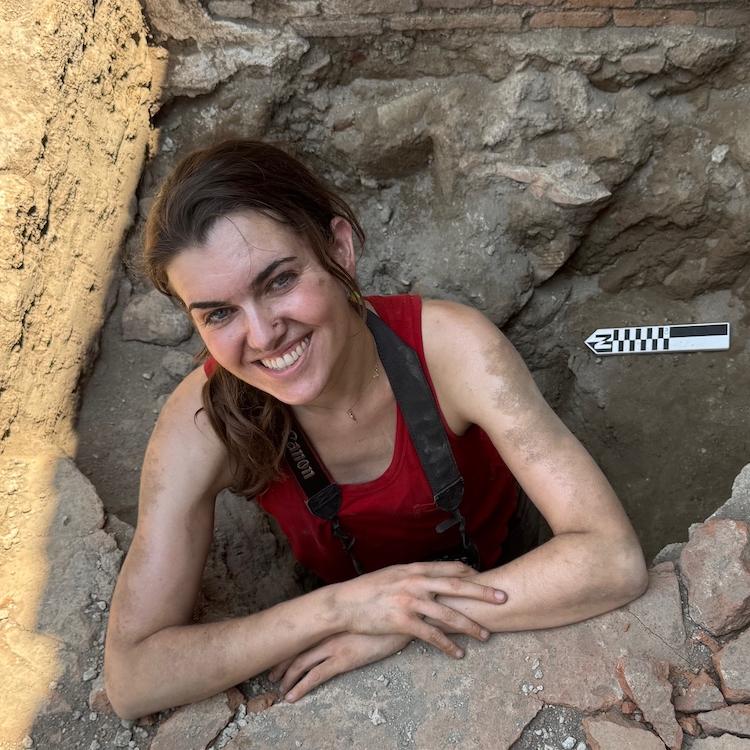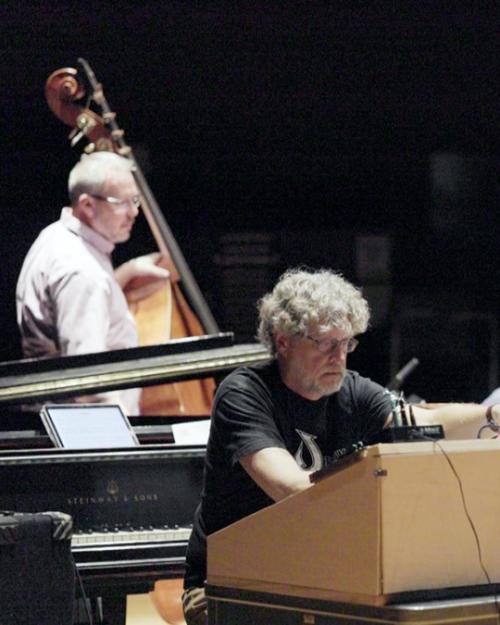A piece of synthesizer history has been given an unexpected second life and is now a part of Cornell’s instrument collection, after eight months of meticulous and often confounding work by a group of synthesizer builders.
The rebuilt and rewired instrument, designed by theorist David Rothenberg and built by renowned synthesizer pioneer Robert Moog, Ph.D. ’65, is housed in Lincoln Hall and graduate student composers will begin experimenting with its unique tonal range next semester.
Xak Bjerken, professor of music in the College of Arts and Sciences (A&S), played the instrument for its first-ever public performance Oct. 24 in Barnes Hall.
“The keyboard is unique in the world – a view into a pivotal movement in electronic music history,” he said.
The keyboard’s restoration was led by Travis Johns, a composer and instrument builder who was a visiting lecturer in music in the fall of 2022. Johns was helped in the project by doctoral student Christopher Rooney, Damon Hollenbeck ’25 and J Nation ’23.
“This project, while admittedly ambitious, has been an absolute blessing,” Johns said. “Only at Cornell would one have the opportunity not only to work with and restore a lost, obscure piece of musical history, but to be part of the process that allows it to actually be heard for the first time.”
Moments of synchronicity
Rothenberg was a musical and mathematical theorist interested in pattern perception, a concept that could be applied to diverse fields such as speech and accounting. He was particularly interested in exploring harmonic scales and how they were heard by humans.
Take, for example, the octave. On a traditional keyboard, an octave is a cycle of 12 tones. But the keyboard that Rothenberg wanted to build would have an octave composed of 31 tones.
Rothenberg’s keyboard was funded in part by a grant from the Air Force Office of Scientific Research, said Suhasini Sankaran, Rothenberg’s widow, who donated the instrument to Cornell. The military hired Rothenberg for work related to pattern recognition, a critical component of artificial intelligence today. He then hired Moog to build the instrument, which comprised a keyboard and an analog synthesizer with a bank of oscillators.
Moog was the ideal person for the job. As a doctoral student studying engineering physics at Cornell in the mid-1960s, he had invented the first commercial electronic musical instrument – known as the “Moog Synthesizer” – which would ultimately crop up in everything from progressive rock to disco and funk. After his studies, he moved to Trumansburg, a village outside of Ithaca, where he established his first synthesizer factory.
During their collaboration, Rothenberg and Moog were not always in perfect harmony. They disagreed about how the oscillators should be connected to the instrument; Rothenberg felt the oscillators should be synced, and Moog did not, Sankaran said.
“The instrument was useless for David’s purposes, or for anyone’s, because one could not compose on it,” Sankaran said.
So the effort was abandoned. Rothenberg gave away the bank of oscillators to a synthesizer museum, although he kept the keyboard in hopes of getting someone else to work on it. That never happened. Rothenberg died in 2018.
In March 2022, Sankaran donated the instrument to Cornell.
“This is a piece of history,” Sankaran said. “My only hope is that it would be preserved.”
Once the keyboard arrived at Cornell, it was housed at the Cornell Center for Historical Instruments, and faculty in the Department of Music began to think about its restoration. In February 2023, after months of trying to figure out where to even begin, Johns and his students got down to work.
“It was honestly a little overwhelming when we first saw the keyboard,” said Nation, who is now working on a master’s degree in music technology at Georgia Tech.
Johns also felt overwhelmed, but eventually he figured out a way to capture the unique tonal range that Rothenberg and Moog had struggled to achieve. He used programmable microcontrollers that were designed to take in a master frequency (which, in this case, was an 8 MHz clock signal), divide by a specified integer and then divide the result several times to create a single circuit with several octaves of the same note. Johns and his students then wired key after key after key – hundreds of times – to these controllers.
The results were otherworldly.
“Since all voices are derived from a single 8 MHz oscillator, there will always be a point where the resultant soundwaves will sync up and in the case of several of the more exotic intervals, these moments of synchronicity would combine to form an entirely new, complex sound,” Johns said, “akin to something you would encounter in the realm of a science fiction soundtrack, as opposed to individual tones produced by an electric organ.”
The instrument’s sounds were not only futuristic. They were unpredictable and one-of-a-kind.
“What surprised me the most while building this instrument was how it seemed to manifest its own voice, personality and characteristics over the course of construction,” Johns said. “At least on paper, things were pretty formulaic – press this button, make this sound. But by the time we started wiring keys, it’s like it took on a life of its own. Different timbres emerged, certain intervals seemed to develop particular characteristics, one note appeared louder than another – all things that, according to the schematics, shouldn’t be happening.”
As the restoration progressed, Johns delivered weekly updates to Bjerken.
“They were way over my head, but seeing the inventive thinking and craftsmanship that went into this amazed me,” Bjerken said.
The crew was fine-tuning the instrument right up until the October concert.
During the performance, Bjerken received a helping hand from Elizabeth Ogonek, associate professor of music and a collaborator on the Cornell ReSounds project. Since the instrument doesn’t have a sustain pedal, Ogonek manually adjusted its filters via knobs that Johns had installed so Bjerken wouldn’t have to release the keys.
The concert also featured new student-created instruments built through the Cornell ReSounds Project, which is funded by an A&S New Frontier Grant.





